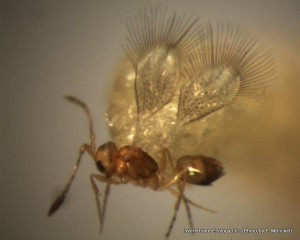
IE staff have reported the discovery of a rare tiny wasp species, Mymaromella Pala, in a part of the United States where it has never before been collected. The discovery, reported in the most recent Western North American Naturalist, fills in a big gap in scientific knowledge. Previously, the species had only been reported in Ontario, Canada and in seven U.S. states, California, Maryland, Michigan, New York, North Carolina, South Carolina, and Virginia. The discovery was reported in a paper in the Western North American Naturalist.
While doing consulting work for the Kootenai Tribe of Idaho, our staff discovered six specimens of the wasp in the summer of 2008 in Lincoln County, MT. The specimens were collected by Kootenai tribal biologists while participating a study on the ecological effects of Libby Dam operations on the Kootenai River and floodplain.
The species, less than one-half millimeter in length, is one of the smallest animals known to mankind. It could sit fairly comfortably on the tip of a sewing needle. The species wasn’t officially described in the scientific literature until 2008. It is one of only two species of the family Mymarommatidae that occur in North American. Little is known about the biology of M. Pala. It is thought to inhabit upland and riparian forests. It is also thought to be an egg parasitoid of bark lice, thus helping to regulate bark lice populations.
Entomologist and former Dean of the University of Idaho’s Plant, Soil and Entomological Sciences Department, James “Ding” Johnson, confirmed the identification of this rare wasp.





Leave a Reply